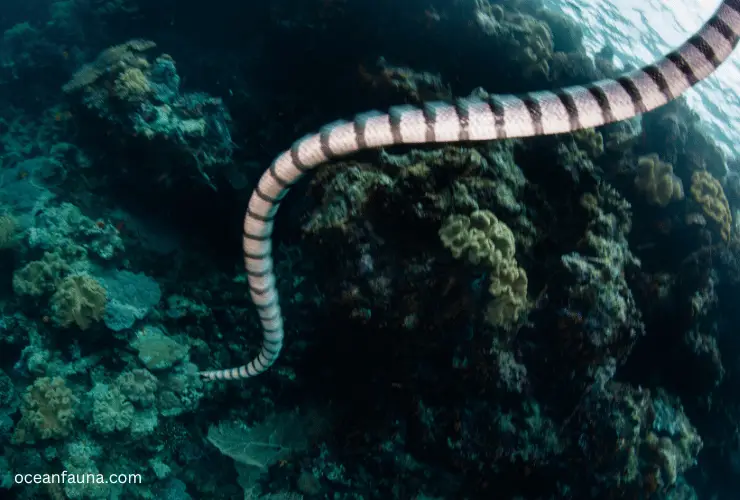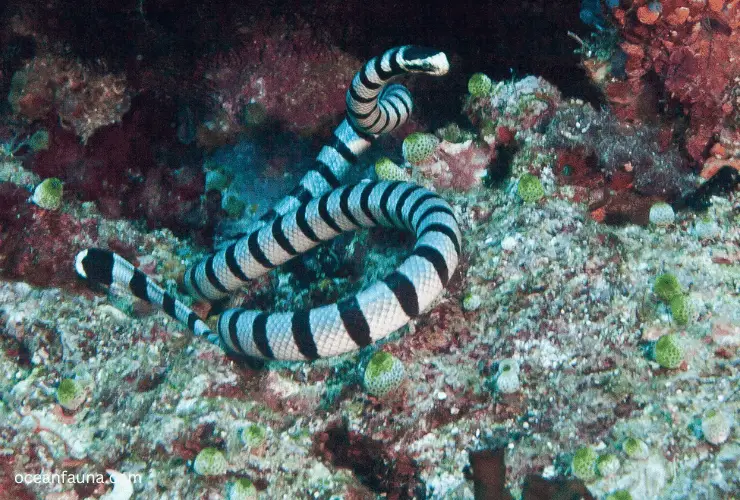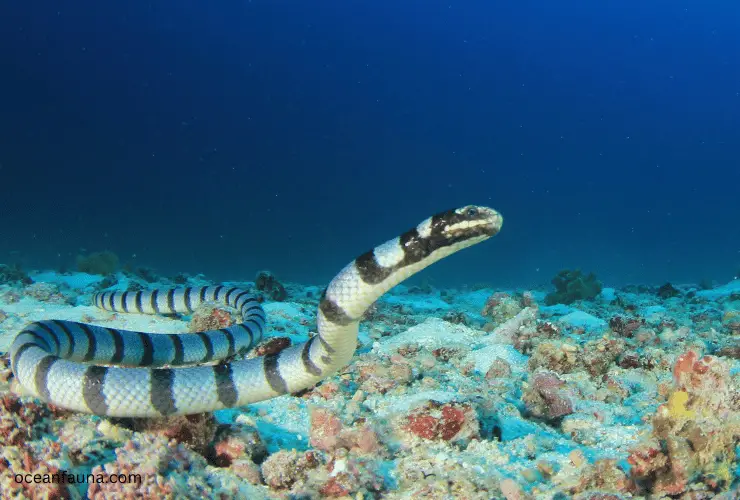Meet the yellow-lipped sea krait – one of the deadliest snakes in the world. These snakes are venomous and do not bike unless provoked. Other names for these snakes are colubrine sea krait or banded sea krait. These amazingly venomous snakes have yellow snouts and black stripes, making them beautiful and distinct from other species.
Yellow-lipped Sea kraits have a distinct paddle-like tail used for swimming in the sea. Most of the time, they reside in the water but digest, rest, and reproduce on the land. It’s one of their specialties to use neurotoxic venom to prey on small fishes and eels. What’s more? They are dangerous and can attack if they feel threatened.
This article will be interesting because we will discuss the yellow-lipped sea kraits’ sea life. Everything related to it will be discussed here. This wild snake is poisonous, and we will try to answer all the queries in your mind. So, let’s dive deep into the sea of insights about it.
About Yellow-Lipped Sea Krait: Facts and Features
● Kingdom: Animalia
● Family: Elapidae
● Class: reptilia
● Genus: laticauda
● Species: Laticauda Colubrina
● Suborder: Serpentes
● Subphylum: Vertebrata
● Phylum: Chordata
● Order: Squamata
● Size range (Average length of males): 2 ft 10.4 inches – 4 ft 8 inches
● Yellow-lipped Sea krait lifespan: 20 years (maximum)
About Yellow-Lipped Sea Krait Habits and Lifestyle
The habits and lifestyle of these sea kraits are worth considering mentioning here. Yellow-lipped Sea kraits love to live in the water. They also live near coastal areas. Adults amongst yellow-lipped sea kraits spend half their time in water and half on land. In simple words, they are semiaquatic. This is how they are adapted to the environment.
Males hunt in shallower water, while females hunt in deeper water. It’s quite interesting that males are smaller in size. It’s also the reason behind their fast crawling and swimming speed. Their body adaptations help them to swim easily and quickly.
They can still move, although at a slower pace when on land. Sometimes traveling great distances from shore in search of prey, Yellow-lipped Sea kraits eventually make their way back to the islands that are their permanent residences.

They typically forage singly but may form big groups with giant trevally and goatfish. Trevally and goatfish work together with sea kraits to chase prey out of tight spaces, and the kraits then feast on the fleeing prey.
If a sea krait sticks its head into a crack, it may not be able to see any potential threats that may be approaching. The snakes’ tails look and move similarly to their heads. They can trick predators like larger fish, sharks, and birds into thinking the tail is the head.
Diet and Nutrition
According to Animalia’s research,
“Yellow-lipped Sea kraits feed on eels and small fishes. They are carnivores or piscivores.
That’s why they love to eat meat. They are meat eaters.” (Source)
Once their prey is in their grasp, they use their potent venom to render it helpless before swallowing it whole. In addition, the sex differences between these snakes manifest themselves in how they prey.
The smaller eels that men need to eat are only found in shallow water, so they focus their hunting efforts there, while the larger eels that females like can be found in deeper water. Because of this, males engage in more eel hunting than females, who typically only catch one eel every trip.
“The families of eels that they love to eat include Congridae, Muraenidae, and Ophichthidae. The families of small fish that they feed on include Pomacentridae and Synodontidae.” ~ (Source)
Reproductive system (Mating details)
Their mating or reproductive system is absolutely interesting. Reptiles Cove has explained it in detail. Let’s quote it now here:
“Sexual maturity occurs between 18 and 24 months of age in men and 24 to 36 months of age in females. It’s conceivable that these snakes travel to the ground to reproduce. Banded sea kraits, unlike most other species of sea snake, typically lay their eggs on
land, most often on rocks. “
The author further added,
“Females were reported to be capable of laying 4 to 20 eggs. Only the female sea snakes lay eggs. To mate and have babies, they come back to land. The months of September through December are prime mating time, although this isn’t always the case, especially in more tropical regions.” (Source)
Behavior
The banded sea krait swims with the help of its tail, which acts like a paddle and glides back and forth to propel it through the water. Sea kraits, while ashore, modify their slithering swimming motion into a more conventional type of locomotion on hard ground.
Interestingly, it adopts a “side-winding” action like many desert species of terrestrial snakes when it encounters loose materials like dry sand. Although they are most active at night or twilight, they are not typically considered to be strictly nocturnal.
During the day, they tend to assemble in small groups, hiding in nooks and crannies, among tree roots and holes, or beneath discarded items on the beach. To maintain a comfortable body temperature, they will frequently switch between periods of shade and sun.
Interaction With Humans
Even when provoked, banded sea kraits show little interest in biting humans. Some Laticauda Colubrina bites have been recorded, and there is evidence that the species occasionally invade human dwellings and vessels.
Human fatalities from assaults by this species are unheard of, though. These snakes are less interested in humans, and they love to live a happy sea life. They usually indulge in their own life.
Where Do Yellow-Lipped Sea Kraits Live?
Most of the population of yellow-lipped sea kraits live near turtle island, Fiji. The Pacific Ocean is their home. They are quite common in this ocean.
What’s more? Laticauda Colubrina lives in islands and reefs. If we talk about all species of sea kraits, four of the species live in water and mostly in the Pacific Ocean.
What Does A Yellow-Lipped Sea Krait Eat?
Eels are their favorite foods. As we have already stated, they live in water, and it is obvious they are also fish lovers. They eat small species of fish.
They hunt at depths of less than 49 feet. Females eat larger species of eels, and males feed on smaller ones. Moreover, their predators are crabs, sharks, and sea eagles.
How Venomous Is the Yellow-Lipped Sea Krait?
According to Wild Singapore’s research on venomous snakes (yellow-lipped sea krait):
“These snakes are human friendly. They can be called as deadly beauty. It means they are beautiful but deadly for humans if provoked. It is because they have highly toxic venom.” (Source)
What Is the Deadliest Krait Snake?
The banded sea krait is the deadliest krait snake in the world. According to livescience.com, it won number four of the top ten deadliest snakes in the world. They are slow movers and deadly for humans.

They hiss, they slither, and they can bite humans. Their venom directly affects muscles and lungs and prevents someone from moving. The victim can suffocate and eventually die. (Source)
Do Yellow-Lipped Sea Kraits Bite?
Yellow-lipped Sea kraits can bite. Generally, these snakes are not aggressive. But they can bite and kill you. They are shy and calm creatures and try to swim away from humans and other monster creatures.
Are Sea Kraits Friendly?
Yes, they are very friendly. You can meet a sea krait while surfing or swimming in the seawater. Leave them be. Don’t try to provoke them or irritate them. These snakes mind their own business.
To define them more specifically, they are pretty inquisitive. Another simple rule for applying while meeting a sea krait is: don’t touch them and try to stay away from these venomous snakes.
Are Yellow-Lipped Sea Krait Endangered?
Yeah, yellow-lipped sea kraits are endangered. According to Wild Singapore’s researchers, they are “Endangered” and listed in the Red List of endangered species of the world in Singapore. They further explained:
“Pollution and reclamation are those human activities or threats that are threatening the growth of sea creatures. Population of yellow-lipped sea kraits is also affected by these threats.” (Source)
Banded Sea Krait Venom Symptoms
The most common symptoms of a banded sea krait venom bite include:
● Abdominal pain
● Cramps in the abdomen
● Nausea
● Dizziness
● Weakness
● Difficulty speaking or swallowing
● Pain
● Altered mental status
● Coma
● Respiratory collapse
● Thirst
● Sweating
● Headache
These signs or symptoms of a venomous bite of a sea krait can be developed after a few minutes or hours or depending on the health of a human. The actual bite can be painless, but the condition after symptoms can lead you toward serious issues or even death.
According to research given in NCBI about symptoms of sea snakes:
“Vomiting and nausea are the most common symptoms of envenomation of all sea kraits. They can then further lead you towards fatal conditions like coma, breathing problem, heart failure, kidney failure, or even death.” (Source)
Yellow-Bellied Sea Snake Venom Effects
The effects of the venom of a yellow-lipped sea krait are hazardous. Everyone discusses that it’s one of the deadly creatures, but nobody discusses how dangerous it is. That’s why we have decided to answer it in gory detail.

What next, if the yellow-bellied sea snake bites you and its venom enter your bloodstream? The initial signs are similar to the flu, including feeling sick, having a headache, and sweating excessively.
As soon as the neurotoxic venom from the snake enters your body, it begins shutting down your neurological system. The Pelamis poisons are the most vital components of the stew since they are proteins.
Pelamis toxins completely shut down the neurological system by attaching to neurons and blocking their electric signals, preventing movement or feeling from reaching the muscles. If you stop those neurons from firing, you’ll go paralyzed.
Venom can cause cardiac arrest or asphyxia if it reaches the diaphragm or heart. If you make it far enough, your kidneys will fail from overuse due to the breakdown of skeletal muscle and the subsequent release of waste products into the bloodstream.
Is There an Antivenom for Yellow-Lipped Sea Krait?
Yes, there is an antivenom for yellow-lipped sea kraits bites. emedicine.com’s writers have suggested one of the best anti-venoms for this eels-eater snake.
“Antivenin polyvalent sea snake is the drug for the treatment of sea snake bites. This antivenom is prepared from hyperimmune horse globulin for the treatment of N scutatus and Enhydrina schistosa.” (Source)
Research Gate’s research has also suggested the following anti-venom for the treatment of venom of yellow-lipped sea kraits:
“The Antivenin Enhydrina schistose is the only commercially available antivenom for sea snake bites. It is still challenging to obtain Antivenin Enhydrina schistose in some places, although it has been shown to have a good neutralizing effect on the venoms of some species of terrestrial snakes and sea snakes.” (Source)
Yellow-Lipped Sea Krait Fun Facts
Here are a few fun facts about yellow-lipped sea kraits that we want to share with you:
● They are called yellow-lipped sea kraits due to their yellow upper lip.
● These snakes have five names: yellow-lipped sea kraits, banded sea kraits, Laticauda colubrine, colubrine sea krait, and banded sea snake.
● It exhibits
“philopatry”. What does it mean? It means they live like turtles. They swim, eat, and enjoy the water but return to land for rest and digestion.
● The best dive site for watching yellow-lipped sea kraits is the Murex Manado House Reef.
FAQs:
Do sea kraits bite?
Sea krait usually does not bite. But they bite if they become aggressive, threatened, or surprised. Otherwise, these snakes have small mouths and do not harm a person without any reason.
What happens when a common krait bites?
Muscular paralysis is the common outcome when a common krait bites. It may become fatal for the person and can cause issues while breathing. You can imagine how much it can cause harm to yourself.
What does a krait snake look like?
A krait snake may have triangular-shaped bodies in cross-section. They have bands of bold colors. Black, white, yellow, and red are the most common colors or combinations of these colors in these snakes. They have cylindrical bodies and dark and light bands on their tails.
What kind of snake is a krait?
Krait is one of the common species of snakes. It’s the most venomous snake in the world and has caused the most snake bites on human beings. It’s also known as the Bengal krait.
How poisonous is a krait snake?
The venom of a krait snake is ten times more fatal and poisonous than a cobra. You can imagine how incredibly venomous they are. Their venom is neurotoxic and can cause a communication gap between muscles and nerves.
Conclusion
Hope you enjoy reading about these docile amphibians on our site. This is an incredible sea creature who’s enjoying marine life. Stay in touch with us; we will share more information about other sea kraits and distinct types of snakes.


1 thought on “Yellow-lipped Sea Krait | An Amazingly Venomous Snake”